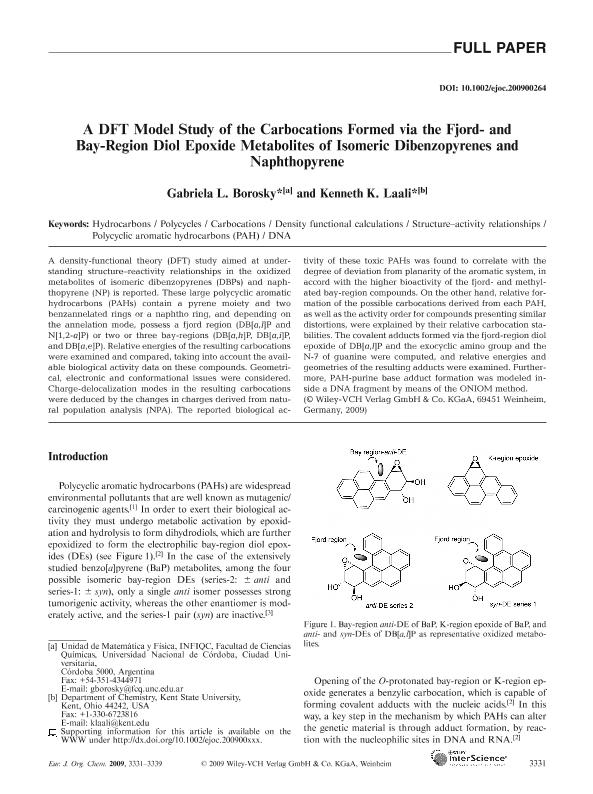Mostrar el registro sencillo del ítem
dc.contributor.author
Borosky, Gabriela Leonor

dc.contributor.author
Laali, Kenneth K.
dc.date.available
2019-05-10T20:27:36Z
dc.date.issued
2009-07
dc.identifier.citation
Borosky, Gabriela Leonor; Laali, Kenneth K.; A DFT Model study of the carbocations formed via the fjord- and bay-region diol epoxide metabolites of isomeric dibenzopyrenes and naphthopyrene; Wiley VCH Verlag; European Journal of Organic Chemistry; 20; 7-2009; 3331-3339
dc.identifier.issn
1434-193X
dc.identifier.uri
http://hdl.handle.net/11336/76098
dc.description.abstract
A density-functional theory (DFT) study aimed at understanding structure-reactivity relationships in the oxidized metabolites of isomeric dibenzopyrenes (DBPs) and naphthopyrene (NP) is reported, These large polycyclic aromatic hydrocarbons (PAHs) contain a pyrene moiety and two benzannelated rings or a naphtho ring, and depending on the annelation mode, possess a fjord region (DB[a,i]P and N[1,2-Ci]P) or two or three bay-regions (DB[a, h]P, DB[a,i]P, and DB[a,e]P). Relative energies of the resulting carbocations were examined and compared, taking into account the available biological activity data on these compounds. Geometrical, electronic and conformational issues were considered. Charge-delocalization modes in the resulting carbocations were deduced, by the changes in charges derived from, natural population analysis (NPA). The reported biological activity of these toxic PAHs was found, to correlate with the degree of deviation from planarity of the aromatic system, in accord with the higher bioactivity of the fjord- and methylated bay-region compounds. On the other hand, relative formation of the possible carbocations derived from, each PAH, as well as the activity order for compounds presenting similar distortions, were explained by their relative carbocation stabilities. The covalent adducts formed via the fjord-region diol epoxide of DB[a,I]P and the exocyclic amino group and the N-7 of guanine were computed, and relative energies and geometries of the resulting adducts were examined. Furthermore, PAH-purine base adduct formation was modeled inside a DNA fragment by means of the ONIOM method.
dc.format
application/pdf
dc.language.iso
eng
dc.publisher
Wiley VCH Verlag

dc.rights
info:eu-repo/semantics/openAccess
dc.rights.uri
https://creativecommons.org/licenses/by-nc-sa/2.5/ar/
dc.subject
Carbocations /
dc.subject
Density Functional Calculations /
dc.subject
Dna
dc.subject
Hydrocarbons /
dc.subject
Polycycles /
dc.subject
Polycyclic Aromatic Hydrocarbons (Pah) /
dc.subject
Structure-Activity Relationships /
dc.subject.classification
Otras Ciencias Químicas

dc.subject.classification
Ciencias Químicas

dc.subject.classification
CIENCIAS NATURALES Y EXACTAS

dc.title
A DFT Model study of the carbocations formed via the fjord- and bay-region diol epoxide metabolites of isomeric dibenzopyrenes and naphthopyrene
dc.type
info:eu-repo/semantics/article
dc.type
info:ar-repo/semantics/artículo
dc.type
info:eu-repo/semantics/publishedVersion
dc.date.updated
2019-05-06T13:46:35Z
dc.journal.number
20
dc.journal.pagination
3331-3339
dc.journal.pais
Alemania

dc.journal.ciudad
Weinheim
dc.description.fil
Fil: Borosky, Gabriela Leonor. Consejo Nacional de Investigaciones Científicas y Técnicas. Centro Científico Tecnológico Conicet - Córdoba. Instituto de Investigaciones en Físico-química de Córdoba. Universidad Nacional de Córdoba. Facultad de Ciencias Químicas. Instituto de Investigaciones en Físico-química de Córdoba; Argentina
dc.description.fil
Fil: Laali, Kenneth K.. Kent State University; Estados Unidos
dc.journal.title
European Journal of Organic Chemistry

dc.relation.alternativeid
info:eu-repo/semantics/altIdentifier/doi/http://dx.doi.org/10.1002/ejoc.200900264
dc.relation.alternativeid
info:eu-repo/semantics/altIdentifier/url/https://onlinelibrary.wiley.com/doi/abs/10.1002/ejoc.200900264
Archivos asociados
